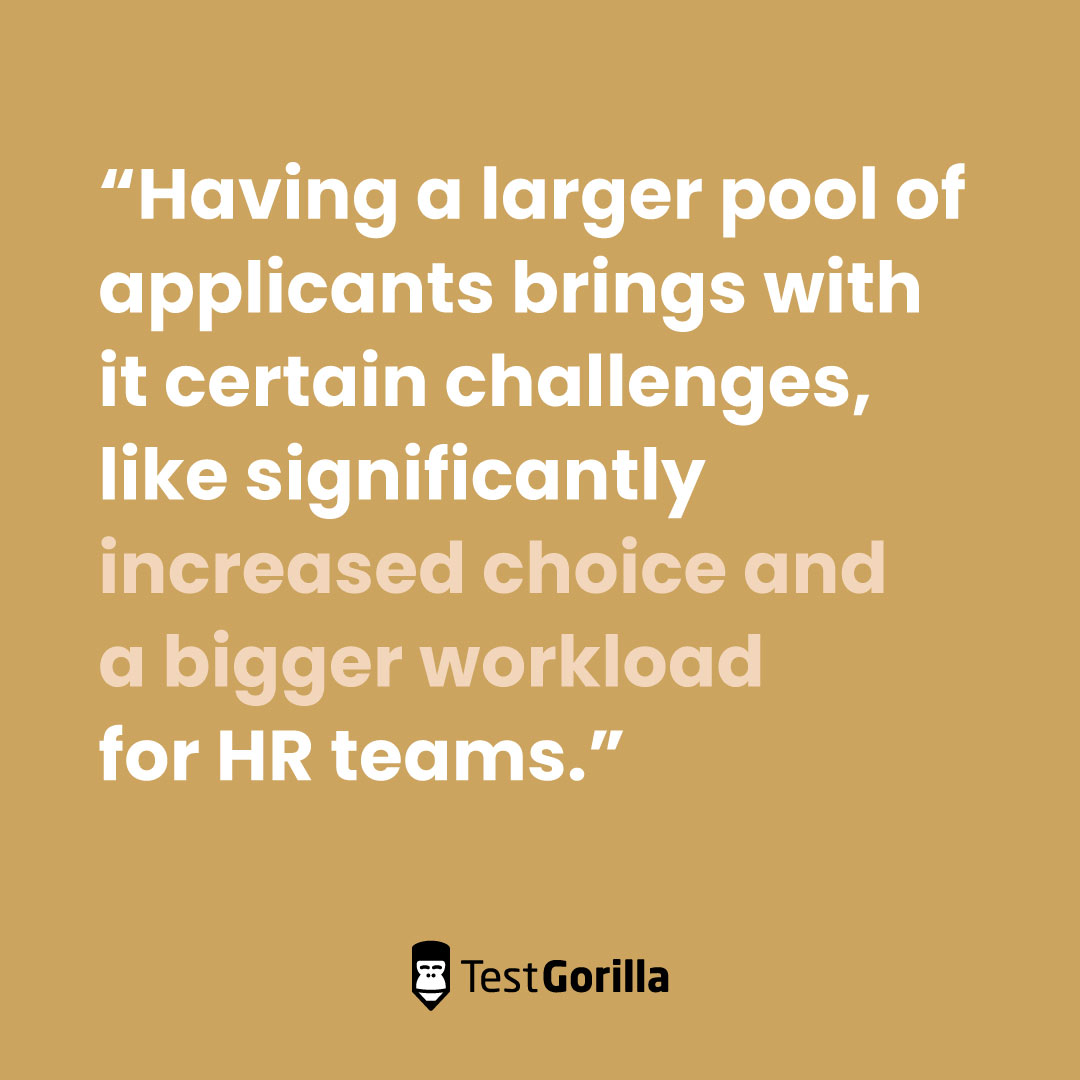If you’ve spent any time on LinkedIn this past year, you’ve seen the unfortunate posts:
“Hi everyone, so unfortunately I was laid off today…”
“15 years at a company, laid off via email…”
“How quickly things change! I was recently laid off, along with many of my talented coworkers, due to unexpected financial challenges…”
“I was laid off again. For the second time in 18 months I find myself at the end of a mass reduction in force…”
Since 2022 and through late 2023, tech layoffs have remained steady: At the beginning of September 2023, Roku announced they’d be letting go of a 10th of their people, and T-Mobile is cutting some 5,000 jobs, about 7% of their staff.[1] These are just a couple of examples of the hundreds of companies still streamlining their workforces.
As a hiring manager, you’re likely even more tuned into the fallout of tech job cuts if you yourself have seen the number of applicants for open roles skyrocket. This may seem like a good thing – more applicants means more candidates to choose from.
However, an overwhelming number of applicants can actually hinder your ability to make the right hires.
We’re here to give you a little background on US tech job cuts, explain the challenges of recruiting in a saturated job market, and guide you through the steps to becoming efficient at hiring when you’re inundated with applications.
Table of contents
US tech job cuts: the causes, the fallout, the state of play
From big-name companies like Google to small startups, 2023 has been a rough year for tech employees. Here’s what’s happened in the industry, why, and how the layoffs are impacting the job market.
US tech layoffs in numbers
While layoff rates began to ease up in early summer, the wave of tech layoffs in 2023 has certainly left its mark. In January 2023 alone, almost 90,000 tech employees lost their jobs.[2]
As of August 2023, total job cuts among tech companies this year added up to over 225,000, exceeding the number of tech layoffs in all of 2022.
It seems no one has been immune – from early-stage startups to mid-sized tech companies, organizations have slashed budgets and laid employees off. However, the biggest job losses in terms of sheer numbers of layoffs come from tech giants like Amazon (16,080 roles), Alphabet (12,000 roles), Microsoft (11,158 roles), and Meta (10,000 roles).[3]
Why so many job cuts in the tech industry?
There isn’t one simple explanation for these mass layoffs; instead, it’s a combination of multiple variables. These factors include:
Economic downturn throughout 2022 and a looming recession
Inflation as high as 9.1% starting in June 2022
Higher interest rates directly impacting venture capitalists (VCs) and startup founders
Investor pressure to decrease expenses
Rebalancing the workforce having overhired during the pandemic
How has this affected the job market?
It goes without saying that more job losses means higher unemployment rates in the tech sector – by March 2023, just 4 in 10 of the workers who had been laid off in the previous year and at the start of 2023 had found a new job.[4]
Unfortunately, these layoffs aren’t impacting all groups of workers equally. While around two-thirds of the tech industry is made up of males, more than half of laid-off employees were female.[5] Additionally, HR roles were the positions most affected by the trend, making up 28% of affected individuals.
These nontechnical roles being cut at high rates means diverse employees are at higher risk of being laid off, as they tend to hold a higher percentage of these positions than engineering roles.[6] On top of this, mass tech layoffs have resulted in significant cuts to DE&I roles – open positions were down 19% in 2022, meaning individuals working in DE&I (who tend to be diverse themselves) have struggled to find new jobs.[7]
The challenges of recruiting in a saturated job market
Anyone experienced in recruiting knows the nuances of hiring in a candidate’s vs. recruiter’s market, and this post-layoff climate clearly favors recruiters, but it’s not all upside from a hiring perspective.
Having a larger pool of applicants brings with it certain challenges, like significantly increased choice and a bigger workload for HR teams.
First off, candidate overwhelm can be hard to manage if you’re not set up to receive hundreds (if not thousands) of applications for each job you post. For example, you may struggle to filter through and vet candidates or properly analyze who’s the best fit for the job.
This choice overload can lead to ineffective decision making, such as relying on go-to determinators like where someone previously worked, who they know, or even something as arbitrary as their resume presentation and formatting.
Worst of all, choice overload makes it easier for unconscious bias to creep in – with such an overwhelming number of candidates to choose from, our mind makes shortcuts based on our implicit biases about the world, whether we’re aware of them or not.
These challenges obviously impact your hiring process, but recruiting in a saturated job market also affects the candidate experience. Too many applications can hinder your ability to communicate effectively and thoughtfully with your best candidates, which could lead to you missing out on an ideal hire.
While you can’t change the number of applications you receive, you can modify your hiring practices to make them more objective, efficient, and effective. Here’s how.
5 steps for efficiently building the best teams in tech
When you’re overwhelmed with applications, you’ll be hard-pressed to find and hire the right people if you’re relying on traditional hiring methods like resumes and cover letters.
This is where skills-based hiring can help.
Follow these five steps for a streamlined and scalable hiring process that will hold up no matter how high candidate overwhelm gets.
1. Conduct a skills-gap analysis to understand your open roles
When you’re operating in a recruiter’s market, you need to be extra clear on which skills your ideal applicant will have. To help you with that clarity and precision, you can use a skills-gap analysis.
The first step is to define your organization’s business objectives by consulting with leadership on medium- and long-term goals. Senior leaders and managers will help you determine where they want the company to go and what skills will be necessary to get it there.
It’s important to consider which parts of your industry might become automated in the future and which emerging skills could benefit your company as it grows and evolves. Remember, these internal conversations should be based around skills, not job titles.
Then, when you’re clear on the skills that will be necessary for the roles you’re trying to fill, it’s time to write your job descriptions.
2. Create a skills-based job description
If you’re going to take a skills-based approach to hiring, skills need to be at the center of your job listings so candidates are clear upfront on whether or not they’re qualified for the role.
To prepare your job descriptions for a skills-based hiring approach, you need to outline specific skills requirements and targets, including a list of the hard and soft skills that will be necessary for the role. We recommend listing at least five skills and describing them adequately so ideal candidates can be confident that they’re the right fit.
For example, the hard skills you list for a backend developer role could include:
When it comes to soft skills, some ideas include problem solving, critical thinking skills, and communication.
Additionally, prioritize responsibilities over requirements. This means not strictly requiring certifications and credentials where possible, and rethinking your “years of experience” minimums.
Finally, show your commitment to reskilling and upskilling by explaining in the job description the type of ongoing support and training employees receive at your company. This helps attract strong candidates by providing evidence of your investment in their professional growth.
Pro tip: Be sure you’re using inclusive language in your job postings. Avoid “coded language” that may discourage certain candidates from applying, such as gender- or age-coded language.
3. Implement talent assessments to evaluate candidates
If you’re implementing skills-based hiring, the most important element is your method for evaluating candidates. That’s where talent assessments come into play.
They’re an especially valuable resource when hiring in a recruiter’s market because they’re a scalable way to objectively assess candidates, as well as easily keep track of applications and test results. This is because talent assessments allow you to automate certain aspects of the hiring process.
With TestGorilla, for example, you can automatically send candidates a link to their assessment via email, with the option to customize these emails or even send them in bulk. Then, you can view the rankings of your candidates by assessment score, giving you an objective view of your best options.
When you narrow down the candidates who stand out the most, you can explore their detailed reports, which outline their answers to your questions and share their video responses.
Instead of sifting through hundreds of resumes and trying to track candidate qualifications on a spreadsheet or in your head, talent assessments give you a data-driven way to evaluate and manage applications, making the process much more efficient, no matter how many people are interested in your open roles.
Pro tip: Come time to run interviews, ask your candidates how they demonstrated the skills you tested them on in prior experiences, be they personal or professional.
4. Follow best practices for assessment creation
For your talent assessments to be successful, you want to be sure you’re asking the right questions and formatting them correctly.
At TestGorilla, we recommend implementing multi-measure testing, meaning you’re evaluating candidates on their cognitive abilities as well as personality and interests.
For example, our test library consists of role-specific, cognitive ability, and personality/culture tests, helping you get a more holistic view of how a candidate would fit into a particular role as well as your organization.
When creating a talent assessment, you can include multiple types of tests (up to five) to evaluate hard skills, soft skills, and personality traits. So if you’re hiring someone for your marketing team, that could mean including a mix of tests like:
You can customize these tests according to the specific role guidelines and your organization’s needs, including additional questions about a candidate’s experience or resume.
Pro tip: If you’re not sure where to start, you can use our assessment templates to simplify and speed up the process of creating assessments. They’re available for numerous roles, from marketing and sales to engineering and design.
5. Pay attention to retaining your new hires
Just because you’ve got them in the door doesn’t mean they’ll stay. Especially in a saturated market, when hiring for an open role is such an undertaking, you want to take extra care to retain your new hires.
Implementing skills-based hiring is a good place to start. As you can see in our State of Skills-Based Hiring Report:
72.1% of people hired through a skills-based approach report being happy in their role
92.7% of companies implementing the practice have reduced mis-hires
91.2% of organizations that hire people based on skills have experienced increased employee retention
Once your candidate has accepted their offer and decided to join your team, pay special attention to the preboarding and onboarding processes. Provide them with the resources they need to feel comfortable and prepared for their new role – this could include setting up a buddy system or mentoring program.
Finally, support your new hires (and your existing employees) with well-being initiatives, whether that’s mental health support, financial coaching, or even a wellness stipend that they can spend however best fits their needs.
Pick the right candidates with skills-based hiring, no matter how saturated the market
Putting skills first when building your team doesn’t just help streamline recruitment.
It can also help you build a more successful business, with skills-based organizations seeing better business results than job-based companies whose employees are boxed into their role responsibilities.[8]
To build a skills-based hiring recruitment process, follow these steps:
Conduct a skills-gap analysis
Create a skills-based job description
Implement talent assessments to evaluate candidates
Follow best practices for assessment creation
Pay attention to retaining your new hires
With 91.4% of companies reducing their total time-to-hire by implementing skills-based hiring, you’ll find the practice makes it much easier to sort and narrow down candidates in a sea of applications. On top of that, the people you hire will be a better fit for the job, meaning happier employees and increased retention.
Choose better candidates in less time with skills-based hiring.
Talent assessments take subjectivity and unconscious bias out of recruitment, helping you hire the right people for your team no matter how many candidates there are.
Download the State of Skills-Based Hiring Report report to learn more.
Sources
“2023 Layoff Tracker: Roku Slashes 10% Of Workforce.” (2023). Forbes. Retrieved on September 6, 2023. https://www.forbes.com/sites/brianbushard/2023/09/06/2023-layoff-tracker-roku-slashes-10-of-workforce/?sh=28e3c7c659c0
“A comprehensive list of 2023 tech layoffs.” (2023). TechCrunch. Retrieved on September 6, 2023. https://techcrunch.com/2023/08/24/tech-industry-layoffs-2023/
“The Crunchbase Tech Layoffs Tracker.” (2023). Crunchbase News. Retrieved on September 6, 2023. https://news.crunchbase.com/startups/tech-layoffs/#:~:text=By%20the%20numbers&text=In%202023%3A%20More%20than%20160%2C233,tech%20companies%20in%20the%20U.S
“The Aftermath of the Big Tech Layoffs: Who Found a Job and Where?” (2023). 365 Data Science. Retrieved on September 6, 2023. https://365datascience.com/trending/the-aftermath-of-the-big-tech-layoffs/
Who Was Affected by the 2022–2023 Tech Layoffs? A Comprehensive Study by 365 Data Science.” (2023). 365 Data Science. Retrieved on September 6, 2023. https://365datascience.com/trending/who-was-affected-by-the-2022-2023-tech-layoffs/
“Tech Industry Layoffs May Undo Workforce Diversity Gains.” (2023). Wired. Retrieved on September 6, 2023. https://www.wired.com/story/tech-layoffs-diversity/
“Big Tech Layoffs Are Hitting Diversity and Inclusion Jobs Hard.” (2023). Bloomberg. Retrieved on September 6, 2023. https://www.bloomberg.com/news/articles/2023-01-24/tech-layoffs-are-hitting-diversity-and-inclusion-jobs-hard
“The skills-based organization: A new operating model for work and the workforce.” (2022). Deloitte Insights. Retrieved on September 6, 2023. https://www2.deloitte.com/us/en/insights/topics/talent/organizational-skill-based-hiring.html
Related posts
Hire the best candidates with TestGorilla
Create pre-employment assessments in minutes to screen candidates, save time, and hire the best talent.
Latest posts
The best advice in pre-employment testing, in your inbox.
No spam. Unsubscribe at any time.

Hire the best. No bias. No stress.
Our screening tests identify the best candidates and make your hiring decisions faster, easier, and bias-free.
Free resources
This checklist covers key features you should look for when choosing a skills testing platform
This resource will help you develop an onboarding checklist for new hires.
How to assess your candidates' attention to detail.
Learn how to get human resources certified through HRCI or SHRM.
Learn how you can improve the level of talent at your company.
Learn how CapitalT reduced hiring bias with online skills assessments.
Learn how to make the resume process more efficient and more effective.
Improve your hiring strategy with these 7 critical recruitment metrics.
Learn how Sukhi decreased time spent reviewing resumes by 83%!
Hire more efficiently with these hacks that 99% of recruiters aren't using.
Make a business case for diversity and inclusion initiatives with this data.




















